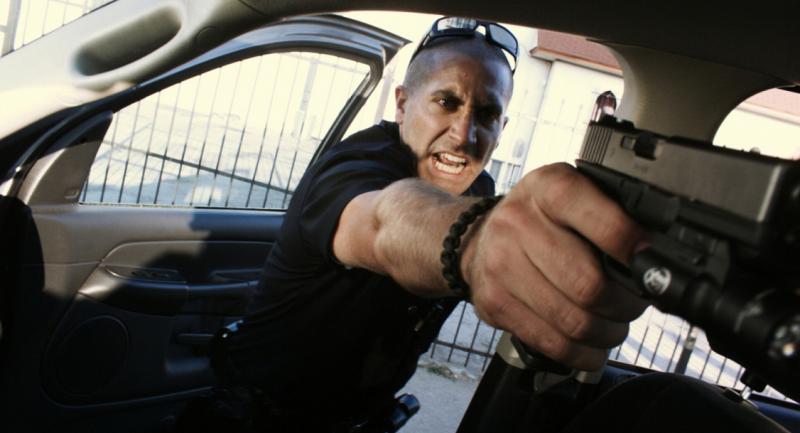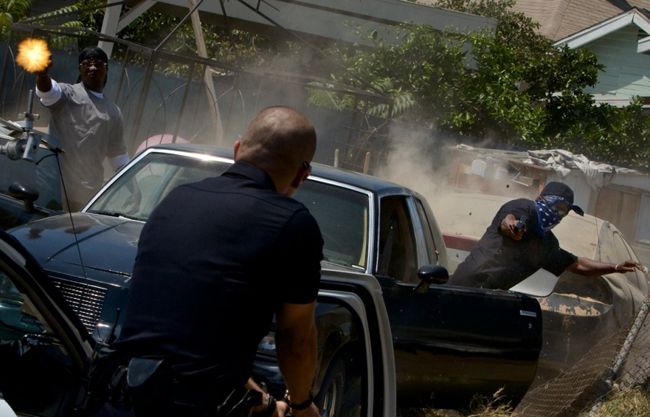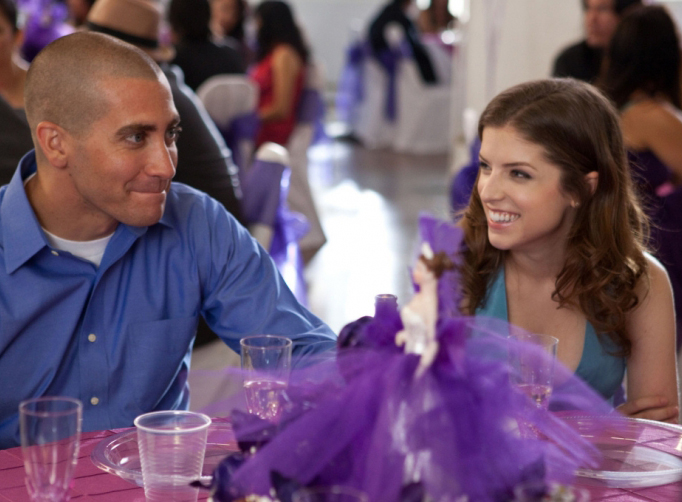End of Watch | reviews, news & interviews
End of Watch
End of Watch
Powerful story of police buddies fighting terrifying LA gangs

There's a temptation to roll your eyeballs upwards when you hear Jake Gyllenhaal's introductory voice-over, which sounds like a corny photocopied mission statement they dish out to all new recruits to the LAPD. "I am Fate with a badge and a gun," he tells us, in his role as Officer Brian Taylor. He didn't make the laws, but he will uphold them with as much force as it takes. The police are the thin blue line.
But Officer Taylor's robotic monotone is violently counterpointed by the images on screen. These are like extracts from TV's Cops With Cameras, except without any edits to protect the squeamish. The fixed lens in Taylor's car gazes unwinkingly as the cops chase a fleeing vehicle, screeching round corners and thumping over kerbs. Then the car crunches to a halt, two armed felons jump out and start firing, until they're methodically mown down by the pursuing officers. The cops look down with shrugging detachment at the bodies. Just another day in South Central LA, is the message (cops vs gangbangers, pictured below).
 End of Watch's writer and director David Ayer has spent most of his professional life making police movies. He wrote Training Day and Dark Blue, and has become resigned to the fact that the cops is his beat. This time (he claims), he wanted to explore the real-life experience of police work, from the emotional bonds of the patrolling officers to their personal off-duty lives.
End of Watch's writer and director David Ayer has spent most of his professional life making police movies. He wrote Training Day and Dark Blue, and has become resigned to the fact that the cops is his beat. This time (he claims), he wanted to explore the real-life experience of police work, from the emotional bonds of the patrolling officers to their personal off-duty lives.
I'm not sure this is quite the novelty Ayer seems to think it is, though the absence of police corruption or political skulduggery makes a refreshing change, but nonetheless End of Watch is a gruelling and powerful movie. Much of its success stems from the convincing rapport between Gyllenhaal's Taylor and Michael Peña's performance as his Mexican-American patrol partner Mike Zavala, the pair of them having spent five months shooting the flick and developing authentic buddy-hood.
Scenes of them cruising around the sleazy, low-rise Los Angeles streets, bantering about wives, girlfriends, making facetious racist jokes or whatever, exude a convincing earthiness. "Drink more coffee," says Taylor to a sleepy Zavala, who's driving. "Dude, I'm on my ninth fuckin' Red Bull," he retorts wearily.
Ayers's technique of assembling the film from a variety of video cameras - hand-held, fixed to dashboards or pinned to uniforms, or street surveillance cams - adds some verité crunch, but verges on the ludicrous when Taylor is fiddling about with his camera when he's about to stick his head round a corner to see if there's a gunman lurking there. Even the gang-bangers record their drive-by shootings on video.
 Yet if you can put this compositional tic aside, always simmering underneath is the unsettling sense that the next freakish or violent incident may be only moments away, and the narrative puts the protagonists on an escalator of steadily ratcheting menace. When they make it to the end of the day and the titular end of watch, the (numerous) cameras follow the playboy-ish Taylor's relationship with Janet (Anna Kendrick, pictured above), and contrast it with Zavala's chaotic but exuberantly happy marriage to his long-standing sweetheart (Natalie Martinez). The action is structured around the developing bond between the two couples. From time to time you imagine there may even be a happy ending.
Yet if you can put this compositional tic aside, always simmering underneath is the unsettling sense that the next freakish or violent incident may be only moments away, and the narrative puts the protagonists on an escalator of steadily ratcheting menace. When they make it to the end of the day and the titular end of watch, the (numerous) cameras follow the playboy-ish Taylor's relationship with Janet (Anna Kendrick, pictured above), and contrast it with Zavala's chaotic but exuberantly happy marriage to his long-standing sweetheart (Natalie Martinez). The action is structured around the developing bond between the two couples. From time to time you imagine there may even be a happy ending.
However, LA's low-life underbelly is a fearsome place indeed, and the police operate in a state of virtual war against horrifically violent Mexican cartels, who are in the process of driving the black gangs out of the area. Taylor is an ex-Marine, and the policing portrayed in End of Watch is more reminiscent of what the military are asked to do in Afghanistan or Iraq than of, say, your local cops in Scunthorpe or Guildford. The moment when an LAPD officer is found with a knife stuck in his eye is like being jolted with a cattle-prod.
 Our heroes (who must be the hardest-working pair of cops in the history of law enforcement) deal with crack-heads who have duct-taped their kids and dumped them in a closet, and rescue other children from a blazing building. This is mere light relief from finding a room crammed with emaciated human-trafficking victims, or busting into a house littered with body-parts and concealing a massive drug stash.
Our heroes (who must be the hardest-working pair of cops in the history of law enforcement) deal with crack-heads who have duct-taped their kids and dumped them in a closet, and rescue other children from a blazing building. This is mere light relief from finding a room crammed with emaciated human-trafficking victims, or busting into a house littered with body-parts and concealing a massive drug stash.
But they become victims of their own success, and they're warned by a federal undercover agent that the cartels have marked their cards (video clip, below). As they're stalked by a rabid Mexican gang, which includes a brace of killer lesbians alongside its roster of tattooed, expletive-shrieking psychos, the tempo builds remorselessly towards a combustible climax. I tottered from the screening feeling battered and wrung-out.
The future of Arts Journalism
You can stop theartsdesk.com closing!
We urgently need financing to survive. Our fundraising drive has thus far raised £49,000 but we need to reach £100,000 or we will be forced to close. Please contribute here: https://gofund.me/c3f6033d
And if you can forward this information to anyone who might assist, we’d be grateful.

Subscribe to theartsdesk.com
Thank you for continuing to read our work on theartsdesk.com. For unlimited access to every article in its entirety, including our archive of more than 15,000 pieces, we're asking for £5 per month or £40 per year. We feel it's a very good deal, and hope you do too.
To take a subscription now simply click here.
And if you're looking for that extra gift for a friend or family member, why not treat them to a theartsdesk.com gift subscription?
more Film
 London Film Festival - a Korean masterclass in black comedy and a Camus classic effectively realised
New films from Park Chan-wook, Gianfranco Rosi, François Ozon, Ildikó Enyedi and more
London Film Festival - a Korean masterclass in black comedy and a Camus classic effectively realised
New films from Park Chan-wook, Gianfranco Rosi, François Ozon, Ildikó Enyedi and more
 After the Hunt review - muddled #MeToo provocation
Julia Roberts excels despite misfiring drama
After the Hunt review - muddled #MeToo provocation
Julia Roberts excels despite misfiring drama
 Ballad of a Small Player review - Colin Farrell's all in as a gambler down on his luck
Conclave director Edward Berger swaps the Vatican for Asia's sin city
Ballad of a Small Player review - Colin Farrell's all in as a gambler down on his luck
Conclave director Edward Berger swaps the Vatican for Asia's sin city
 London Film Festival 2025 - Bradley Cooper channels John Bishop, the Boss goes to Nebraska, and a French pandemic
... not to mention Kristen Stewart's directing debut and a punchy prison drama
London Film Festival 2025 - Bradley Cooper channels John Bishop, the Boss goes to Nebraska, and a French pandemic
... not to mention Kristen Stewart's directing debut and a punchy prison drama
 London Film Festival - from paranoia in Brazil and Iran, to light relief in New York and Tuscany
'Jay Kelly' disappoints, 'It Was Just an Accident' doesn't
London Film Festival - from paranoia in Brazil and Iran, to light relief in New York and Tuscany
'Jay Kelly' disappoints, 'It Was Just an Accident' doesn't
 Iron Ladies review - working-class heroines of the Miners' Strike
Documentary salutes the staunch women who fought Thatcher's pit closures
Iron Ladies review - working-class heroines of the Miners' Strike
Documentary salutes the staunch women who fought Thatcher's pit closures
 Blu-ray: The Man in the White Suit
Ealing Studios' prescient black comedy, as sharp as ever
Blu-ray: The Man in the White Suit
Ealing Studios' prescient black comedy, as sharp as ever
 The Woman in Cabin 10 review - Scandi noir meets Agatha Christie on a superyacht
Reason goes overboard on a seagoing mystery thriller
The Woman in Cabin 10 review - Scandi noir meets Agatha Christie on a superyacht
Reason goes overboard on a seagoing mystery thriller
 London Film Festival 2025 - crime, punishment, pop stars and shrinks
Daniel Craig investigates, Jodie Foster speaks French and Colin Farrell has a gambling habit
London Film Festival 2025 - crime, punishment, pop stars and shrinks
Daniel Craig investigates, Jodie Foster speaks French and Colin Farrell has a gambling habit
 I Swear review - taking stock of Tourette's
A sharp and moving tale of cuss-words and tics
I Swear review - taking stock of Tourette's
A sharp and moving tale of cuss-words and tics
 A House of Dynamite review - the final countdown
Kathryn Bigelow's cautionary tale sets the nuclear clock ticking again
A House of Dynamite review - the final countdown
Kathryn Bigelow's cautionary tale sets the nuclear clock ticking again

Add comment